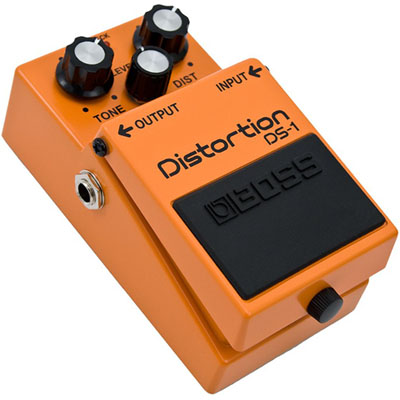
By Ed Malaker
Posted 03/18/2019
Overdrive
Overdrive is usually a naturally occurring clipping of the signal. It’s often created by turning the volume up too loud on the gain stage of the amp, or by using a gain-boosting pedal that makes the signal too hot going into the amp or another pedal. Often, this will drive the later stages of the amp too hard and the signal will begin to clip, or chop off the parts of the signal that are too loud. This distorted sound is oftentimes a warm, pleasing tone that also adds a little compression to the signal. Overdrive is strictly an analog effect, because overloading digital circuits produces a harsh and very unmusical sound. There are many overdrive pedals designed to mimic the sound of natural amplifier overdrive. Take a look at the Boss SD-1 Super Overdrive or Ibanez Tube Screamer.
Distortion
Distortion is the next level of Overdrive. The signal is heavily clipped and compressed with little of the guitar’s original tone left intact. This type of distortion needs to be electronically designed; you cannot Overdrive an amp into Distortion (though you might get close). Some modern amplifiers have Distortion built in, but you generally get great-sounding Distortion from a pedal. Distortion is a very tight sound that is well suited to aggressive and fast styles of music, where you need to keep articulation of each note intact. Music styles such as Speed Metal and any kind of guitar “shredders” almost always use Distortion. Take a look at the DOD Gunslinger Mosfet Distortion, or Pro Co RAT2 Distortion Pedal.
Fuzz
Fuzz is a type of distortion that only comes in a pedal form. It is a lo-fi type of distortion that is meant to sound like a broken speaker or amp. Fuzz is a very “soggy” type of distortion that’s not as good at fast or aggressive music as Distortion. Fuzz is created by pushing transistors beyond their operating parameters in a very similar way to Overdrive, but while Overdrive is meant to preserve your tone as best it can Fuzz is just meant to obliterate it in favor of massive buzz. Two main types of Fuzz are the Maestro’s Fuzz-Tone and the Big Muff Fuzz Tone. The Maestro’s Fuzz-Tone is a brighter, sharper tone that you might know well from the song “Satisfaction” by the Rolling Stones. The Big Muff is a much bigger and warmer-sounding fuzz, very similar to the sound of “Foxy Lady” by Jimi Hendrix. Most Fuzz pedals are clones of these two pedals. Take a look at the Electro-Harmonix Big Muff Pi, or The Outlaw Effects Five O’clock Fuzz.
Bit Crusher
The Bit Crusher effect is hard to categorize, I put it in Distortion because it destroys your signal completely. It is a digital effect that creates the effect by reducing both the sampling rate (down sampling) and the resolution of the signal, resulting in a very low-fidelity sound that is often harsh and distorted. Take a look at the Hotone Krush Bitcrusher Sampler Guitar Effects Pedal, or CNZ Audio Crush Bit Guitar Effects Pedal.
If you’ve found this article helpful, please feel free to share this with your friends on Facebook and Twitter. For more articles on guitar electronics, visit humbuckersoup.com.
